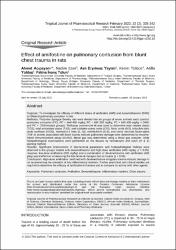| dc.contributor.author | Acıpayam, Ahmet | |
| dc.contributor.author | Eser, Nadire | |
| dc.contributor.author | Yaylalı, Esra Eryılmaz | |
| dc.contributor.author | Tülüce, Kerim | |
| dc.contributor.author | Yoldaş, Atilla | |
| dc.contributor.author | Tolun, Fatma İnanç | |
| dc.date.accessioned | 2023-09-05T05:39:08Z | |
| dc.date.available | 2023-09-05T05:39:08Z | |
| dc.date.issued | 2023 | en_US |
| dc.identifier.citation | Acıpayam, A., Eser, N., Yaylalı, A.E., Tülüce, K., Yoldaş, A. & Tolun, F.I. (2023). Effect of amifostine on pulmonary contusion from blunt chest trauma in rats. Tropical Journal of Pharmaceutical Research , 22(2), 335-342. http://doi.org/10.4314/tjpr.v22i2.16 | en_US |
| dc.identifier.issn | 1596-5996 | |
| dc.identifier.uri | http://doi.org/10.4314/tjpr.v22i2.16 | |
| dc.identifier.uri | https://hdl.handle.net/11436/8242 | |
| dc.description.abstract | Purpose: To investigate the efficacy of different doses of amifostine (AMI) and dexamethasone (DXM) on bilateral pulmonary contusion in rats.Methods: Forty-two Sprague Dawley rats were divided into six groups of seven animals each (control, pulmonary contusion (PC), PC + AMI 400 mg/kg, PC + AMI 200 mg/kg, PC + AMI 400 mg/kg + DXM, and PC + DXM-treated groups). RelAssay commercial kit was used to determine total oxidant status (TOS), total antioxidant status (TAS), and oxidative stress index (OSI). Nitric oxide (NO), inducible nitric oxide synthase (iNOS), interleukin-1 beta (IL-1 beta), interleukin-6 (IL-6), and tumor necrosis factor-alpha (TNF-alpha) activity associated with blunt trauma induced pulmonary damage were determined by enzyme -linked immunosorbent assay (ELISA). Blood gas was determined using a blood gas analyzer, while histopathological examinations were performed on the tissues by hematoxylin and eosin (H & E) staining method.Results: Significant improvement in biochemical parameters and histopathological findings were observed in the groups treated with dexamethasone and high-dose amifostine (400 mg/kg; p < 0.05). However, low-dose amifostine (200 mg/kg) and a combination of dexamethasone with amifostine (400 g/kg) was ineffective in balancing the biochemical changes due to trauma (p > 0.05). Conclusion: High-dose amifostine combined with dexamethasone mitigates trauma-induced damage in rat by preventing the elevation of key inflammatory markers. Further preclinical and clinical studies are required to determine the efficacy of amifostine in humans and to compare its activity with other agents. | en_US |
| dc.language.iso | eng | en_US |
| dc.publisher | Pharmacotherapy | en_US |
| dc.rights | info:eu-repo/semantics/openAccess | en_US |
| dc.subject | Pulmonary contusion | en_US |
| dc.subject | Amifostine | en_US |
| dc.subject | Dexamethasone | en_US |
| dc.subject | Inflammatory markers | en_US |
| dc.subject | Chest trauma | en_US |
| dc.title | Effect of amifostine on pulmonary contusion from blunt chest trauma in rats | en_US |
| dc.type | article | en_US |
| dc.contributor.department | RTEÜ, Tıp Fakültesi, Cerrahi Tıp Bilimleri Bölümü | en_US |
| dc.contributor.institutionauthor | Tülüce, Kerim | |
| dc.identifier.doi | 10.4314/tjpr.v22i2.16 | en_US |
| dc.identifier.volume | 22 | en_US |
| dc.identifier.issue | 2 | en_US |
| dc.identifier.startpage | 335 | en_US |
| dc.identifier.endpage | 342 | en_US |
| dc.relation.journal | Tropical Journal of Pharmaceutical Research | en_US |
| dc.relation.publicationcategory | Makale - Uluslararası Hakemli Dergi - İdari Personel ve Öğrenci | en_US |


















